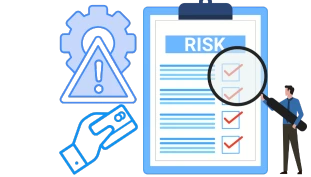
Opening and operating a gun range business is no easy task. Its high-risk nature, stringent regulations, and considerable starting costs are some of the top reasons you should think carefully before taking the leap. However, if you’re ready to move forward, this guide covers all the essentials to start and run a gun range business successfully. Read on to learn how to get yours up and running in today’s growing firearms market.
TABLE OF CONTENTS
- Key Takeaways
- Understanding the Gun Range Business
- Legal and Licensing Requirements: Navigating the Regulations
- Safety and Compliance Essentials
- Business Planning and Financial Considerations
- Setting Up Your Gun Range: Key Equipment & Operations
- Reliable Payment Processing for Gun Ranges
- Gun Range Business FAQs
Key Takeaways
- Since 2024, there have been 8,468 gun range businesses across the US.
- The industry’s revenues are growing at a compound annual growth rate (CAGR) of 6.3% and reached a record $5.7 billion in 2024.
- According to research, opening a static indoor shooting range will cost around $230,000 to $500,000.
- Securing a loan might be challenging for firearms businesses since they are considered high-risk. This categorization may cause processors to be wary of working with gun range merchants due to the increased potential for chargebacks and other liabilities.
Understanding the Gun Range Business

As of 2024, the number of gun range businesses in the US was 8,468. Shooting ranges experienced growth in popularity over the past decade, with revenues in the industry growing at a compound annual growth rate (CAGR) of 6.3%, reaching a record $5.7 billion in 2024. This was majorly supported by increased gun enthusiasm and disposable income from consumers.[1] IBSWorld. “Shooting Ranges in the US – Market Research.” Accessed March 26, 2025. With the firearms customer base expanding, it’s a great time to get started in this field.
However, before opening a gun range business, you must first understand your target market. Generally, individuals between the ages of 25 and 64 are the most significant demographic for gun range businesses because they hold the largest share of disposable income. Data from a Firearm Industry Trade Association survey shows that adult participation in sport shooting grew by 24.1% between 2009 and 2022. Of the total number of adults involved in sport shooting, women accounted for 32%, compared to 26% in 2009.[2] NSSF. “Firearm Ownershop & Sport Shooting Participation.” Accessed March 26, 2025. Once you understand who your main demographic is, you can flesh out your business plan even further.

Indoor vs. Outdoor Ranges: Pros and Cons
Choosing the type of shooting range you want to establish is essential. Each option has advantages and potential pitfalls, so you should weigh the pros and cons of each before making a decision.
Indoor
Pros:
- You can operate an indoor shooting range year-round, regardless of the weather.
- You can open this type of range anywhere (in urban, suburban, or rural areas), which will increase your consumer base.
- You can have an easier time controlling noise through proper soundproofing.
Cons:
- The cost of opening an indoor shooting range is usually higher than that of an outdoor range. This pricing difference is due to the need for advanced infrastructure, such as HVAC systems for air quality control, soundproofing to reduce noise pollution, and lead filtration systems to manage hazardous materials.
- Your shooting range will have limited distances compared to outdoor ranges.
- You may experience stricter zoning and safety regulations, which may affect the caliber types and shooting you can offer.
Outdoor
Pros:
- Outdoor ranges don’t require advanced construction, so startup costs can be lower than indoor ones.
- You have more shooting space, which is essential for giving shooters more realistic training scenarios.
- There is more flexibility in facilitating competitions, events, and training courses.
Cons:
- You may not be able to operate year-round because outdoor shooting ranges are weather-dependent.
- It may be hard to contain noise pollution, especially as houses encroach your range.
- Because of the considerable land requirements, you may have to open your shooting range further away from urban areas. This can make your business less accessible, potentially reducing your customer base.
Legal and Licensing Requirements: Navigating the Regulations
A gun range business has several licensing requirements and regulations you must understand and comply with. These will vary depending on the state and locality, so you need to determine what applies to you so your business doesn’t face disruptions.

Zoning Laws and Local Regulations
Understanding the zoning requirements of your state and local areas is important when determining where you will put your gun range business. Zoning laws are usually established at the county or city government level. While state governments may establish guidance for these laws, they cannot explicitly direct their development and enforcement. These laws usually address several factors, including:
- Location: There are laws in place that limit the firing of rounds within specific distances of occupied buildings. Depending on your city, there are locations where you can’t open a gun range business at all.
- Zoning: Local governments usually design regulations on land use, fire codes, and business ordinances at their discretion.
- Operating Hours: Local regulations may also set limits on when you can operate, usually to address noise pollution. Indoor ranges may have lenient hours due to their containment, while outdoor ranges may be restricted to day-only operations.
A good place to find information on zoning requirements and local regulations is by contacting your local government office. They are best suited to give you specific and accurate information depending on the type of shooting range you want to open. Additionally, you can leverage the Bureau of Alcohol, Tobacco, Firearms, and Explosives website for more information.

Permits and Licenses You Need to Operate
Once you determine the laws and regulations you must follow, you can now focus on the licenses you’ll need. Some of these include:
- State and Local Business Licenses: A gun range business is like any other business but with higher risk. Therefore, you must obtain general operating licenses, which typically involve registering your company name and choosing a business structure. Other licenses may include a SOT license, which grants you the status to manufacture or sell firearms as outlined by the National Firearms Act.
- Federal Firearms License (FFL): While this isn’t a mandatory requirement, obtaining a federal firearms license has its advantages. For instance, if you want to start selling firearms at your range, you’ll need an FFL license.
- Firearm Safety and Training Certifications: These licenses may only be applicable if you offer training courses or certifications at your shooting range. For instance, the National Rifle Association (NRA) offers certification for individuals who own or work in gun ranges and want to teach shooting courses.
Safety and Compliance Essentials
Safety is key when running shooting ranges. It’s critical to perform the necessary protocols to ensure your shooting range is accident-proof. This involves adhering to general security requirements and training your staff. These include:
- Have an Emergency Action Plan: In case of emergencies, your shooting range must have a plan in place to maintain it and keep your customers safe. This plan can include things like first-aid procedures, evacuation routes, and how to secure firearms during a crisis.
- Adopt Ammunition and Firearms Restrictions: It’s a common practice for ranges to restrict certain ammunition and firearms. For instance, both indoor and outdoor shooting ranges restrict steel-core ammo because it damages backstops and steel targets and can cause ricocheting. As for firearms, most indoor ranges forbid shotguns and rifles.
- Hire Range Safety Officers (RSOs): Certified RSOs are essential in shooting ranges to enforce range rules, train shooters, and respond to emergencies. Your staff can obtain certification through organizations like the NRA by taking an online or an in-person course with a Chief RSO.

Main Penalties for Violating Safety Regulations
If your gun range violates safety and compliance regulations, such as gun laws in the US, you should be prepared to deal with the consequences.
Fines are the most common penalty that gun ranges often face, depending on the type of violation. For instance, the Occupational Safety and Health Administration (OSHA) can issue fines of up to $70,000 for unsafe working conditions, such as a lack of protective gear for your RSOs and other staff members.
Lawsuits are another consequence you should prepare for. If a patron or staff member gets injured in your shooting range, they can sue you for negligence. If you’re at fault, you may have to agree to settlements that can cripple your business financially.
Last but not least, authorities may revoke your licenses if you engage in unlawful actions. For instance, the ATF can revoke FFLs for several reasons, such as failing to conduct background checks on customers, turning down ATF’s requests to conduct inspections, and falsifying records.[3] ATF. “Revocation of Firearms License.” Accessed March 26, 2025.
Business Planning and Financial Considerations
Before opening a shooting range, create a business plan to guide implementation and financing procurement.

Strong Business Plan & Effective Marketing Strategies
Creating a business plan is the first and most important step when launching a firearms business. The business plan provides direction for securing finances, attracting customers, and promoting business continuity. It also tells lenders and investors that your business has potential and that you’re invested in its success.
Essentially, your business plan should include:
- Market Analysis: This provides information on your market research results, including your target demographic, competition, customer demand, and market gaps.
- Funding Requirements: When applying for a loan, estimate the cost of your gun range business and outline it in your business plan.
- Business Model: How will you generate revenue? Aside from offering recreational shooting services, do you plan on selling firearms, hosting events, or offering training courses?
- Marketing Strategy: Will you attract and retain potential customers by leveraging traditional, digital, or hybrid strategies?

Startup Costs and Budgeting: How Much Does It Cost to Open a Gun Range?
The financial aspects of opening a gun range business are key. You might have a great idea, but without the monetary means to implement it, your idea could fail to materialize. That’s why having a rough idea of the costs is essential.
Generally, the amount will depend on whether you choose an indoor or outdoor gun range. Research shows that opening a two-lane static indoor shooting range will cost about $230,000 to $500,000.[4] MILO. “How Much Does it Cost to Build an Indoor Shooting Range.” Accessed March 26, 2025. The price can be higher if you want an outdoor range, which requires purchasing or leasing land. Of course, rates will be lower if you already own the land.

Financing Options to Fund Your Shooting Range
Once you determine how much it will cost to set up and operate your gun range business, there are several ways you can finance your business, including:
- Self-financing
- Personal loans from banks (if the business is a sole proprietorship)
- Business loans
- Grants
- Crowdfunding
However, it is worth noting that securing a loan might be challenging as firearms businesses are deemed high-risk. When a business falls into this category, some processors and banks may be wary of taking that company on since there could be an uptick in chargebacks and other liabilities.
Setting Up Your Gun Range: Key Equipment & Operations
You’ll need space to set up your gun range. This can be on a standalone piece of land (outdoor) or in a building (indoor). Once you have a location, you’ll require equipment such as:
- Guns
- Ammunition
- Safety gear
- Targets
- Shooting benches
- Gun bag
- Range dividers
You’ll also need staff to help manage and run the business. It’s best to hire RSOs to prevent accidents and cases of negligence.
Reliable Payment Processing for Gun Ranges

When you’re ready to start receiving customers, having a reliable payment processor is essential for accepting payments. However, since the Federal Deposit Insurance Corporation (FDIC) lists gun retailers (including gun ranges) as high-risk businesses, you may have trouble qualifying for certain payment processors.
However, there are gun-friendly merchant service providers who can help you find a reliable payment processor. With the right team on your side, you can successfully navigate the ins and outs of running a gun range business.
Gun Range Business FAQs
What are the legal requirements to open a gun range?
Legal requirements will vary with local and state laws regarding zoning laws, building permits, noise ordinances, and safety standards. Additionally, licenses and permits like the FFL will depend on your business operations. Therefore, it’s best to consult your local government office for specific details on necessary permits and compliance measures.
Do you need an FFL to open a gun range?
No. You may only need an FFL if your gun range intends to sell firearms and ammunition.
Are gun ranges profitable?
Generally, yes. However, it will depend on how you run the business. If you meet all the requirements, comply with regulations, and have effective market strategies, your gun range business will become profitable in the long run.
How many acres do you need for a gun range?
It depends on the type of shooting range. If you’re planning on opening an indoor shooting range, the average size is two acres of land. For outdoor ranges, sizes may reach up to 500 acres, especially if you want to accommodate long-distance shooting.






